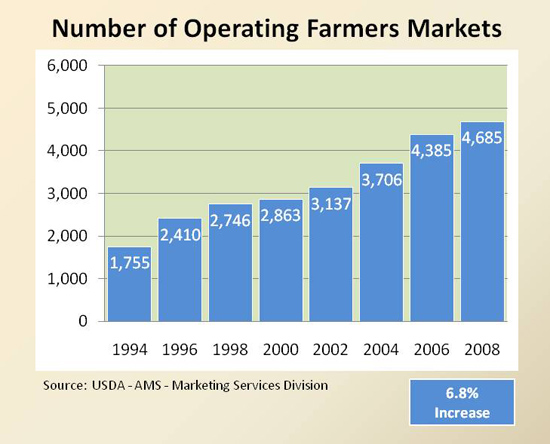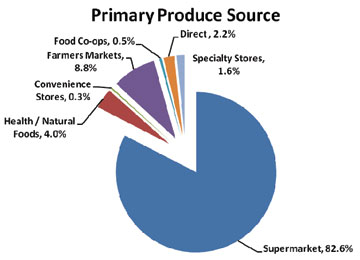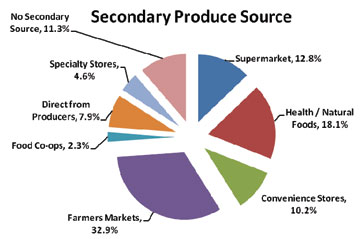by D. Thilmany and C. Thomas1 (6/09)
Quick Facts…
- The United States Department of Agriculture reported that since 1994, the number of farmers markets nationwide has grown by nearly 3,000 and continues to grow.
- Colorado has seen a dramatic increase in farms that are marketing directly.
- Over 40 percent of consumers noted farmers markets were a major source of fresh produce, and if you add consumers who buy directly from producers, the number increases to over 50 percent.
Farmers markets have a rich history in the development of agriculture in the United States. They represented a community food distribution system long before the rise of the retail agribusiness system, and began to re-emerge (after years of decline) after the passage of the Farmer-to-Consumer Direct Marketing Act of 1976. Some argue that they are now an integral part of the food community, linking consumers and producers through business and social relationships. Others view farmers markets as an appropriate marketing channel for entrepreneurial and small farmers who strive to establish a loyal customer base through personal selling and high quality (vs. low margin commodity) marketing strategies.
By examining trends in the number of farmers markets, sales made directly by producers and the role of farmers markets in consumer food purchases, one can assess the potential role of such channels in agricultural development, especially for small farms or producers with specialty and value-added agricultural products.
Farmers Marketing Trends
The U.S. Department of Agriculture reported that since 1994, the number of farmers markets nationwide has grown by nearly 3,000 and continues to grow. As of August 2008, the total number of farmers markets in the nation had reached 4,685, a 6.8 percent increase from August 2006 (http://www.ams.usda.gov/farmersmarkets/).
Direct marketing via roadside stands and community supported agriculture (CSA) is also on the rise. As of March 2004, a study published by the Leopold Center
 |
| Figure 1: Growth in Farmer’s Markets, 1994-2008 Source: United States Department of Agriculture- Agriculture Marketing Services, Division. |
at Iowa State University found 1,034 CSAs in the national database, an increase of more than 25 percent in three years. A count in July 2005 showed 1,144 in the USDA database (http://attra.ncat.org/attra-pub/csa.html#trends).
On the supply side of local food systems, the number of farms turning to direct sales within a broad context of options is growing at a similar rate. According to the 2007 Census, 136,817 farms (6 percent of all farms) sold a little over $1.2 billion in agricultural products direct to consumers. Although this is only about 0.5 percent of total sales, it is a 50 percent increase in sales from 2002. This growth translates into about 20,000 more farms selling direct and each farm selling about $2,000 more per farm annually. Small farms (under $50,000 of annual sales) represent a large share of farms that sell directly; almost two-thirds of sales come from farms of this size, and these farms represent three-quarters of the growth in sales.
Direct Marketing by Producers
Data on direct marketing from the 2007 Ag Census shows some interesting trends in the U.S. and Colorado. For the U.S., the value of agricultural products directly sold by producers increased from $812,204,000 to $1,211,270,000 between 1997 and 2002, an increase of 49 percent compared to a less than 4 percent increase in total revenues sold through all channels. The number of farms direct marketing also increased from 116,733 to 136,817 and the average direct sales per farm increased from $6,958 to $8,853.
| • Mesa $4,729,000 |
| • Adams $2,260,000 |
| • Weld $2,203,000 |
| • Delta $1,529,000 |
| • Morgan $1,509,000 |
Colorado has seen a dramatic increase in farms that are marketing directly. Between 2002 and 2007, 434 farms began direct marketing (2,777 up from 2,343) so that 7.5 percent of all farms do some direct marketing (compared to 6.2 percent for the U.S. as a whole). This increase in activity resulted in revenue from direct sales increasing from $17,406,000 in 2002 to $22,584,000 in 2007. Average sales per farm increased from $7,429 to $8,133. These revenues include channels outside of farmers markets (roadside stands, CSAs and pick-your-own) but still illustrate the significant shift in marketing strategies by Colorado producers.
Within Colorado, there are concentrations of producers who sell the most directly, and not surprisingly, they are in areas near metropolitan consumer populations and areas that receive a large number of tourists. The top counties in terms of revenue from direct sales are:
Of these, Morgan county showed the greatest growth with an almost 800 percent increase in direct sales from 2002.
Farmers Markets in Consumer Food Shopping
 |
 |
| Figure 2a and 2b: Primary and Secondary Food Shopping Locations. |
There is little research on the role of farmers markets in U.S. consumers’ food shopping behavior, but a Colorado State University study asked consumers about their primary and secondary fresh produce source choices. Although supermarkets dominate as the primary source of fresh produce (Figure 2a), 8.8 percent of consumers consider farmers markets to be their primary fresh produce source, and 32.9 percent of consumers consider farmers markets to be their secondary fresh produce source. These consumer trends, together with the growth in direct sales by agricultural producers, documented by the Censusfor Agriculture, clearly show the growing popularity of personal sales relationships with consumers.
There are broader community and policy issues that relate to farmers markets and direct marketing as well. There are some who believe that public support for these markets should grow, but it is not clear how much support is needed. The USDA reports that 82 percent of markets are already self-sustaining and market income is sufficient to pay for all costs associated with the operation of the market (not including grant or in-kind support). But, this may be misleading, as the study focused on existing markets, and there is no information on what other markets might exist if public support were available. Sally Haines, with the Colorado Farmers Market Association, believes that most Colorado markets still rely heavily on volunteers, support for facilities and unpaid management. This is especially true in more rural areas, where there is an insufficient consumer base relative to what is necessary to support a market’s overhead.
With respect to broader food policy concerns, farmers markets appear to play a significant role in food security and assistance. According to the USDA, 58 percent of markets participate in WIC coupon, food stamps, local and/or state nutrition programs. But again, Colorado does not reflect these national trends, as Colorado does not participate in either the WIC Farmers Market Nutrition Program or the Senior Farmers Market Nutrition Program (FMNP). However, three markets in Colorado fund their own version of the FMNP. Furthermore, 21 Colorado farmers markets participate in the CFMA EBT (Food Stamp) program, and offer electronic benefits transfer (EBT) capability at their markets. To support more localized assistance efforts, 25 percent of markets participate in gleaning programs aiding food recovery organizations in the distribution of food and food products to needy families.
References
Colorado Department of Agriculture-Markets Division. Farm Fresh Directory. https://ag.colorado.gov/category/farm-fresh
Payne, T. 2002.
US Farmers Markets—2000: A Study of Emerging Trends. Agricultural Marketing Service, USDA, Washington, DC
USDA Agricultural Marketing Service. Farmers Market Directory – https://www.usdalocalfoodportal.com/
USDA Agricultural Marketing Service. 2000. Farmers Market Study.
1D. Thilmany, Colorado State University Extension specialist and professor; C. Thomas, graduate research assistant; agriculture and resource economics. 6/09.
Colorado State University, U.S. Department of Agriculture and Colorado counties cooperating. Extension programs are available to all without discrimination. No endorsement of products mentioned is intended nor is criticism implied of products not mentioned.
Go to top of this page





